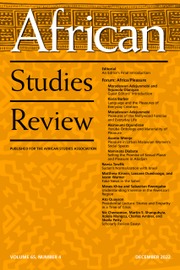Zambia’s Copperbelt suffers from no lack of scholarly attention. Situated astride the rich ore deposits of the Katanga Basin, the region has been a reliable source of mineral wealth and social and political developments for at least a millennium. Copper production lubricated Indian Ocean trade networks and in the seventeenth and eighteenth centuries Lunda kingdoms constructed networks of affiliation based on control of extractive rights and technological expertise. When the region attracted European and American investment in the 1930s, the Copperbelt became the focal point for new forms of capitalist production in (then) Northern Rhodesia and emerged as its most important urban center. Throughout the decade, colonial officials animated by racial assumptions about “rural Africa” openly worried about the impact of city life on black labor, which resulted in the founding of the famed Rhodes-Livingstone Institute in 1937. Since then, the Copperbelt has continued to elicit important contributions from anthropologists, economists and historians on issues as wide-ranging as African urbanism, labor movements, gender expectations, the emergence of African political activism, and modernism.
Hyden Munene’s book Copper King in Central Africa argues that the thematic nature and short time duration of many of these studies has left a critical dimension of the history of the Copperbelt underexplored—the performance of copper corporations over time. Mining companies not only provided the impetus for urban development, but since corporate decisions were nested in the complex interplay of global economies and local interests, attention to corporations challenges and complicates conclusions previous scholars have drawn about life on the Copperbelt.
In a meticulously researched and neatly organized volume, Munene takes up Andrew Roberts’s 1982 call for “a ‘sustained attempt’ to synthesize the disparate themes of corporate organization, labor relations, and profitability … to produce an integrated political, economic, and social history” (4, 15). The book traces the narrative of a single company, the Rhokana Corporation, from its inception in 1928, through nationalization in 1970, ending in the privatization movement of the early 1990s. It is arranged in six chapters that follow Rhokana and its Nkana mine chronologically through the Great Depression and the interwar economy (Chapter Two), the copper boom of World War II and the Korean War (Chapter Three), the siphoning of Northern Rhodesian mine profits by the Central African Federation (Chapter Four), the Zambianization of the early independence period (Chapter Five), and two successive phases of nationalization (Chapters Six and Seven). Each chapter addresses three main themes—Rhokana’s corporate organization, labor relations, and profitability.
The greatest benefit in Munene’s microscopic analysis lies in his ability to index earlier scholarly work on the Copperbelt against the performance of Rhokana in the long term. This quantitative approach takes good advantage of corporate, union, and UNIP archives that are available only in Zambia and reaps interesting results for historians of the region. Copper King shows, for example, that while the stock market crash of 1929 prompted a decrease in copper prices and production globally, Northern Rhodesian companies were able to leverage low-cost labor and cooperative relationships with energy and transportation providers to ensure profitability and gain a comparative advantage over American and Chilean producers during the Depression. Resistance to this dual-labor model, entrenched by 1935, spurred unionization and claims for higher wages in the 1940s. In this postwar context, as profits should have decreased relative to rising labor, fuel, and transport costs, Munene demonstrates that the years from 1950 to 1953 were a boom for copper profits thanks only to the spike in demand resulting from the Korean War. During the same period, he challenges the accepted narrative of Rhokana’s resistance to African Advancement—the gradual training of black Rhodesians to work in previously white-dominated mine jobs—by showing that the corporation was the first to open negotiations with the white Northern Rhodesian Mine Workers Union in an effort to reduce labor costs. And in the era of nationalization under Kenneth Kaunda (1970–91), the author shows that mine profits declined less from incompetent management than from declining ore quality, complications from deeper mining, and the complex problems associated with rising transport costs and international tensions.
Munene’s concentration on the crucial Rhokana Corporation in Copper King is certainly justifiable, but at moments it makes the argument myopic. For example, recent scholarship on the Copperbelt suggests that urbanization did not solely hinge on the profitability of the mines. A brief comparison of Rhokana’s Nkana mine with other mining towns such as Solwezi might have overly complicated the narrative, but it might also have nuanced the book’s conclusions. And while the politics of Northern Rhodesia/Zambia have always revolved to a degree around copper, corporate structure and profitability do not fully explain the racial logic of the dual labor system or the way both political identity and social service provision made the Copperbelt unique. While these lie largely outside the book’s main lines, Copper King nevertheless makes compelling reading. Munene’s rich use of data never bogs down into minutiae, and his clear organization makes Rhokana into a character of real interest itself. As importantly, Munene’s willingness to challenge convention will undoubtedly prompt productive debate among scholars of the Copperbelt. It is to be hoped, as the author suggests, that a further volume might discuss developments after 1991.


